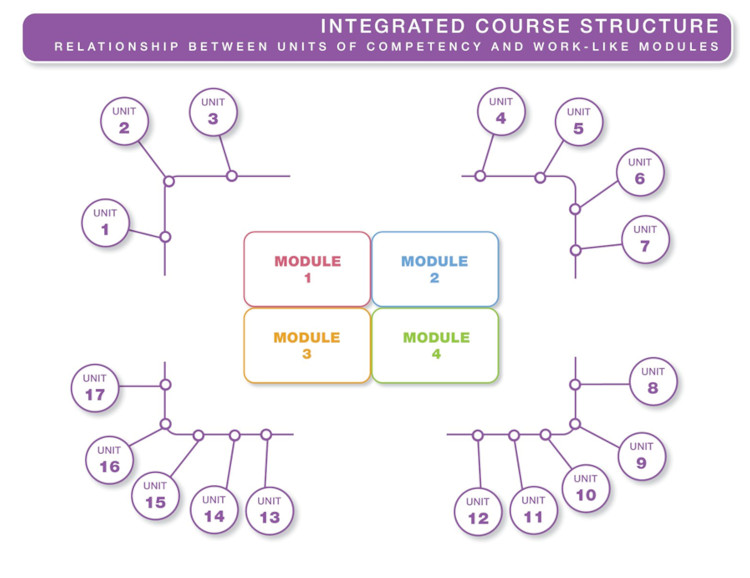
Study Modes
Structured and flexible options: Online, In-Class, or Accelerated.
Most training providers deliver courses one unit at a time, with lots of repetition and dozens of separate assessments. ITAC takes a smarter approach. We combine related skills into a smaller number of practical, workplace-based topics. You still learn all the required skills and knowledge—often more—but in a way that’s faster, easier to follow, and better prepares you for real work.
Most training organisations follow the old method: they teach one unit at a time. Each unit has its own separate assessment, even if the content is very similar or identical. This leads to:
For example, some courses have 15 to 32 separate units. If each one takes 4 to 6 weeks, that’s 1 to 2 years of study—even longer if you need a break or fall behind. And much of that time is spent doing tasks you've already mastered.
ITAC’s integrated model fixes this problem. Instead of working through one unit at a time, we combine related content into a smaller number of topics that match how jobs actually work.

ITAC’s unique integrated approach means:
Even though you do fewer tasks, nothing is left out. You still meet all national requirements and often cover more than in traditional delivery—just in a smarter, more efficient way.
| Course | ITAC’s Integrated Approach | Traditional Approach |
| CHC30221 Certificate III in School Based Education Support |
3 modules 4–6 months |
15 units 12–18 months |
| CHC40221 Certificate IV in School Based Education Support |
4 modules 4–6 months |
17 units 18 months |
| Education Support Combo (CHC30221 + CHC40221) |
4 modules 4–6 months |
32 units 24 months |
| CHC30121 Certificate III in Early Childhood education and Care |
3 modules 4–6 months |
17 units 12-18 months |
| CHC50125 Diploma of Early Childhood Education and Care |
4 topics + placement 6 months |
15 units 12-18 months |
| ECEC Combo (CHC30121 + CHC50125) |
4 topics + placement 9 months |
32 units 24–36 months |
All durations include theory and placement.
Take the concept of confidentiality. In a typical course like Education Support, students are asked to show they understand confidentiality in nearly every unit—often using the exact same wording.
In traditional delivery, this means completing separate assessments to prove the same thing over and over again. Students might write a short answer response, case study or reflection ten or more times on the same topic just to meet unit-level requirements.
This isn’t unique to confidentiality. It’s a common issue across most qualifications, including Early Childhood and Education Support, and affects many core areas:
ITAC’s model fixes this. These overlapping skills are assessed once or twice—within real-world tasks that reflect how they’re actually used in the job.
Below is a real example from CHC30221 Certificate III in School Based Education Support, showing how confidentiality appears across the core units:
| Unit Code | Example Requirement Related to Confidentiality |
| CHCEDS033 | Legislation impacting workers: confidentiality and privacy |
| CHCEDS034 | Policies and procedures: maintaining confidentiality of student records |
| CHCEDS035 | Importance of confidentiality in relation to child information |
| CHCEDS036 | Follow confidentiality procedures when handling student records |
| CHCEDS037 | Maintain student confidentiality at all times |
| CHCEDS057 | Legal and ethical requirements: confidentiality and privacy |
| CHCEDS059 | Maintain confidentiality of student health information |
| CHCEDS060 | Legislation: confidentiality and privacy |
| CHCEDS061 | Legislation: confidentiality and privacy |
| CHCPRT001 | (Implicit) Confidentiality in relation to child protection reporting |
| CHCDIV001 | (Indirect) Respecting privacy and rights of others |
This repetition is typical across many skills and knowledge areas. Our integrated model removes the duplication while keeping full compliance—ensuring students meet every requirement without wasting time.
ITAC’s integrated model can reduce your study time by 12–18 months compared to traditional courses. That means starting work much earlier—and earning a full salary while others are still studying.
What does that mean financially?
You also save on childcare, transport, and other study-related costs. And because you start working sooner, you gain earlier access to job promotions, experience, and long-term career opportunities.
ITAC’s integrated model isn’t just more efficient—it’s more effective. You’ll finish sooner, with fewer assessments, stronger skills, and real-world confidence from day one. It’s a smarter way to study, and a better way to build your future.
Ready to get started? Explore your course options or speak with our team today.
Finish faster with our streamlined dual-qualification model—exclusive to ITAC.
Trainer visits and tailored support during your school or childcare placement.




Experienced trainers across major Australian cities, providing tailored support and local insights throughout your studies.
24/7 access to our comprehensive digital resources, allowing you to study at your own pace, wherever you are in Australia.
Dedicated team committed to your success, offering academic guidance and practical assistance to help you balance study with life's demands.

Experience our range of innovative programs at ITAC, enhancing your educational journey towards success.



